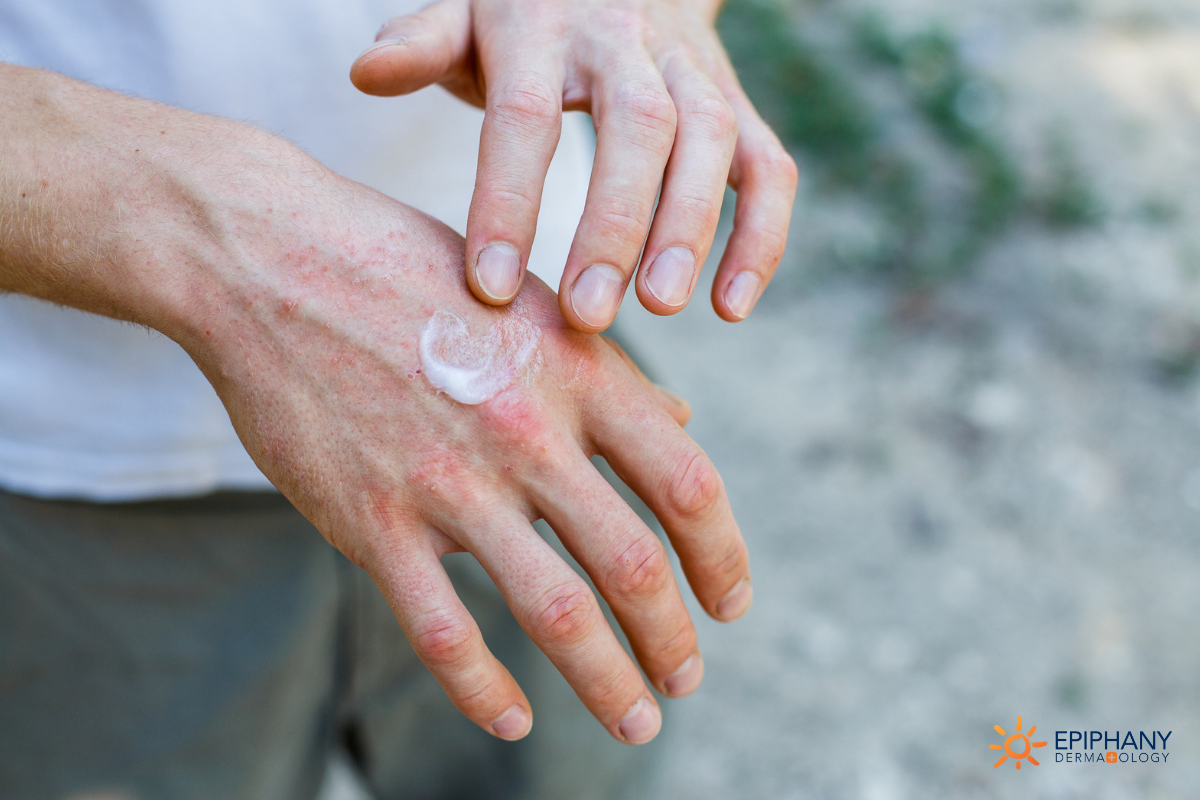Have you noticed a pink, scaly spot on your skin that never seems to go away?
If so, it’s time to visit your dermatologist, as you could be experiencing the first signs of actinic keratoses. Although it’s not dangerous on its own, it’s a warning sign of the potential for skin cancer in the future.
Actinic keratoses are one of the most common issues we see in the dermatology clinics. It’s evidence that the skin has had too much sun exposure. Because of this UV damage, the skin hasn’t been able to regulate growth and now produces pink, scaly lesions on the skin. If left untreated, these can develop into a squamous cell carcinoma.
Don’t avoid dealing with spots you suspect may be actinic keratoses. Instead, think of actinic keratoses as a good thing — it’s your body’s cue that it’s time to intervene.
How Do I Get Actinic Keratoses?
Actinic keratoses don’t play favorites. Anyone can develop these spots, no matter their ethnicity, gender, or race. It’s UV exposure that affects your susceptibility to developing actinic keratoses. These rashes usually appear in patients over the age of 40 after years of sun damage.
Patients with a history of skin cancer need to closely monitor their skin for signs of actinic keratoses or any other suspicious spots. Prior skin cancer has already indicated significant UV exposure and damage to the body. That inherently puts you at risk to develop actinic keratoses as well as future skin cancers. In fact, about 60% of people diagnosed with a basal cell carcinoma or squamous cell carcinoma will have a second diagnosis within 10 years. Further, multiple skin cancer diagnoses also indicate an increased risk for other cancers. If you have a history of skin cancer, keep a regular schedule of follow-up appointments to catch actinic keratoses or any other suspicious spots or symptoms before they progress.
How Can I Spot Actinic Keratoses?
Patients first notice actinic keratosis as a scaly, gritty sensation on the face. Sometimes, it takes on a red color. It feels thick and flaky, almost like a scab that never quite heals. In some cases, it fades and reappears over a long period of time.
These spots come and go as the body fights unhealthy cells. For a time, our body can fight it on its own, healing the pink area. But later, the scale comes back, and the cells start to grow and turn over more quickly than the body can heal. As the cells turnover, they stack up and begin to create a thick pink scale.
Because of the “come and go” nature of actinic keratoses, people tend to delay visiting their dermatologist.
Don’t.
If you ever have something new, changing, or an area of the skin that just doesn’t feel right for longer than six weeks, your dermatologist needs to evaluate it.
What is Actinic Keratosis vs. Seborrheic Keratosis?
Actinic keratosis vs. seborrheic keratosis may sound similar, but they are quite different. While actinic keratosis is due to UV damage and signals a warning for future skin cancer, seborrheic keratosis is a benign growth spot that develops because of genetics. Typically, seborrheic keratoses run in your family. These brown, waxy spots grow to a point, then stay consistent in size. They will not bleed and should not hurt.
Seborrheic keratosis is often confused for a mole, but these spots are not true moles. They are made from different types of cells and never have the potential to turn into a dangerous issue like melanoma. Seborrheic keratosis is not dangerous and will not develop into skin cancer.
What Actinic Keratosis Treatment Options Do I Have?
Not all actinic keratoses will develop into skin cancer, however most dermatologists will want to remove them as a precaution. In-office actinic keratosis treatments include cryotherapy or photodynamic therapy.
For patients who prefer a topical medication for their actinic keratosis treatment, we prescribe creams or topical gels that work over a period of several weeks to destroy these cells.
Whenever you notice a rash, spot, or irregularity on your skin that doesn’t seem to heal, it’s time to visit your dermatologist. They’ll be able to evaluate the issue and recommend a treatment plan that’s right for you. Don’t ignore the signals your body is sending you. Actinic keratoses are your cue to make an appointment today.

Dr. Julia Kreger is a board-certified dermatologist in Glenwood and Vail, CO. She specializes in the prevention, early detection, and treatment of skin cancer, as well as improving the aesthetics of patients’ skin. Dr. Kreger is an active member of the American Academy of Dermatology, the American Society of Mohs Surgery, the Women’s Dermatologic Society, and the Colorado Dermatologic Society. In her spare time, she is an avid outdoorswoman, having climbed 95 of Colorado’s Centennial Peaks. She enjoys skiing, long distance running, and spending time with her fiancé and three dogs.
Learn more about Dr. Kreger.

